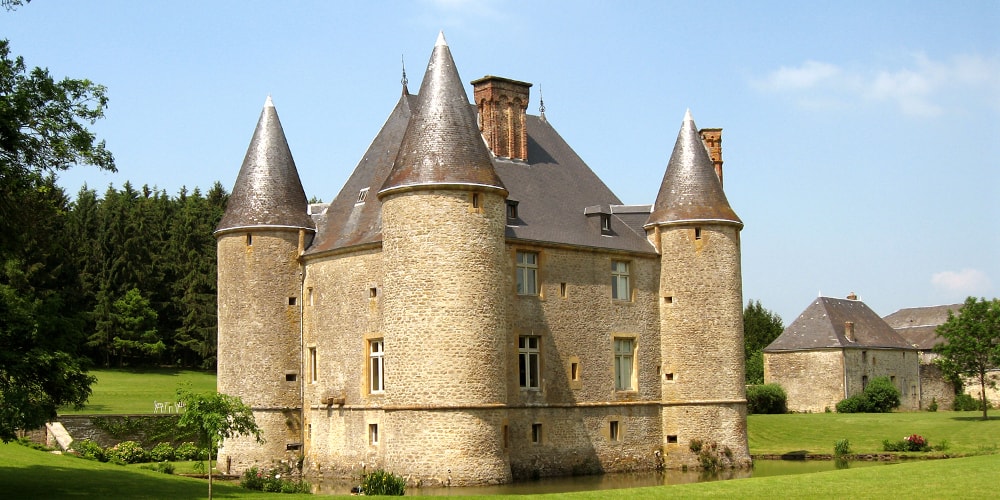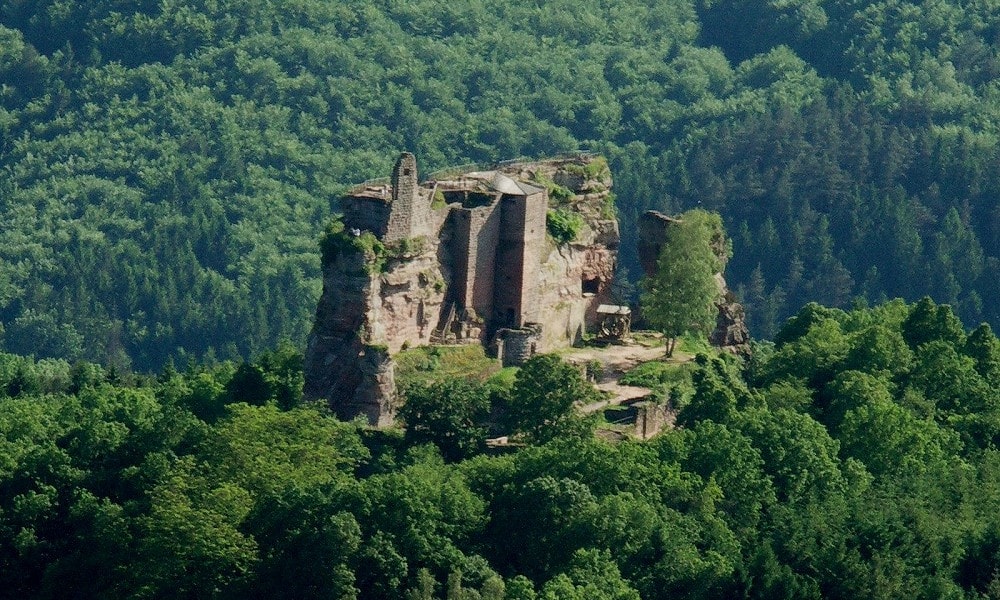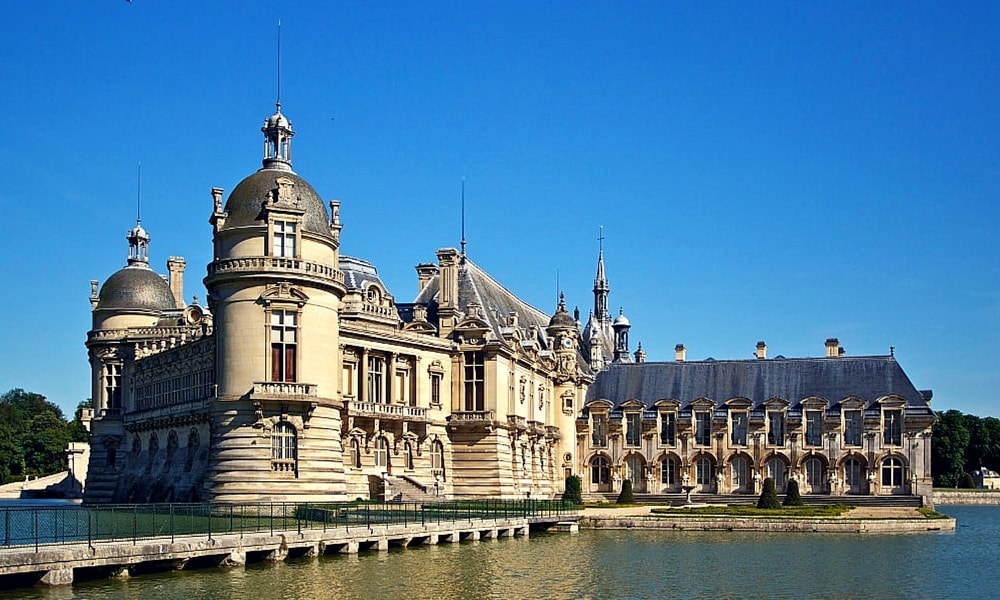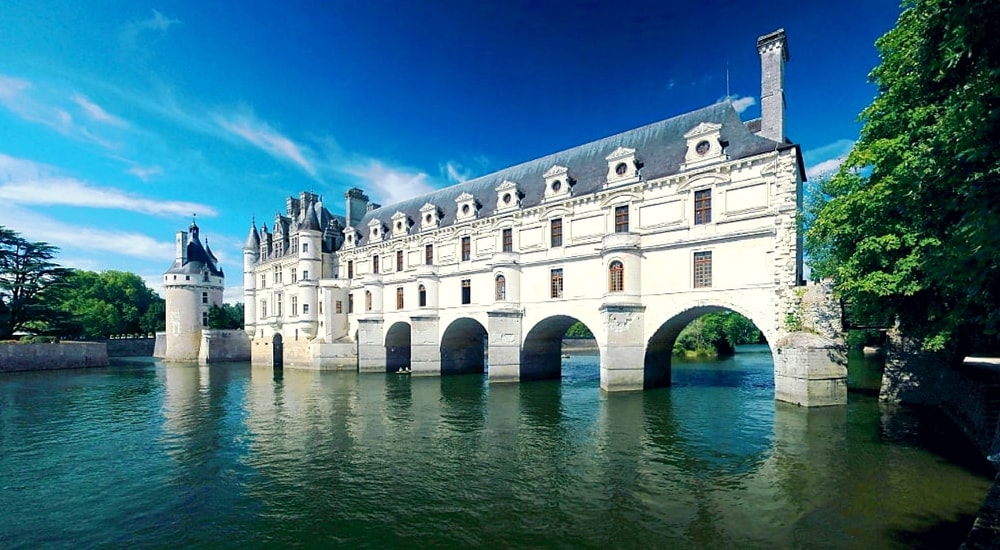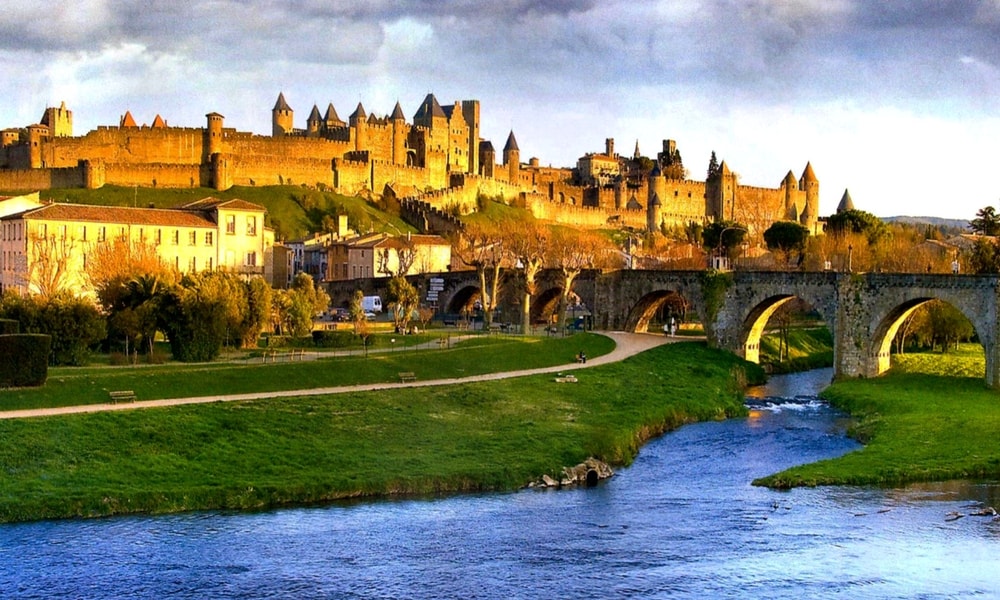
Top 20 most beautiful castles in France
A great number of picturesque castles and fortified towns with rich histories can be found throughout France. France has hundreds of the continent’s most impressive and beautiful castles and forts. Check out twenty of the most beautiful of these architectural wonders that are just waiting to be discovered by travelers.
20.Castle of Landreville
The Castle of Landreville is a charming example of an intact manorial residence built in the pre-Renaissance period in the Ardennes region.
It takes the form of a rectangular strong house, flanked by four cylindrical towers and surrounded by water-filled moats, within a six hectares park with green grass, stables and two nice pavilion houses from the 18th and 19th centuries.
In 800 years of history it has witnessed the lives of many noble families, including the Landrevilles, Chennerys, Beauvais and others; many wars have started, finished or just passed true here.
The current building dates from the middle of the 16th century, but its rectangular plan with four towers designed to provide protection for the four sides has been widely used since the 15th century. This design ...... view details
19.Castle of Sedan
The Castle of Sedan is a grand medieval fortress that dominates the city of Sedan with its impressive stature.
History
The Castle is one of the largest feudal fortress in Europe; its construction took more than 150 years until it was finally completed. The fortress was originated around 1424 by Eberhard II von der Mark, who built a small manor house with two twin towers. The fortress was further reinforced by his son and completed by Robert II de la Marck (Eberhard grand-grandson) who finished the most important work.
In the first part of the 16th century, the fortifications were modernized: the curtain wall was thickened by an additional 26 metres and a circular terrace with cannon was constructed. The bastions were ...... view details
18.Castle of Fleckenstein
The Castle of Fleckenstein was once an impregnable fortress built high above the forests of the Vosges and the Palatinate. The castle was erected in the late 12th century on a sandstone summit in the shape of a long boat.
The castle is named after the Fleckenstein family, who owned the castle until 1720. After that, the castle changed hands several times until it became the property of the French state after the end of World War I.
An intelligent system for collecting rainwater was designed for the castle during the Middle Ages: a small cistern was fed and an elevation allowed the rainwater to be moved to the upper floors.
Castle of Fleckenstein had a long history; it has been modified and modernized many times, captured by ...... view details
17.Castle of Puymartin
Located on a steep hill in the deep Perigordian forest, the Castle of Puymartin draws visitors attention with its crenelated towers. With strong defensive walls and a substantial main building, it has still the appearance of a medieval castle despite the many changes that were made over the years.
History
The castle was built in the late 13th century and, like many of the castles in the region, it played a key role during the Hundred Years War, and later in the Wars of Religion. At the beginning of the Hundred Years War, it formed the border between France and England; as a result, it changed hands several times during the war between French and English. The castle was destroyed towards the end of ...... view details
16.Castle of Bonaguil
The Castle of Bonaguil was the last fortified castles built in France during the Middle Ages. When it was constructed, it was considered a marvel of military architecture that incorporated the latest development in defensive protection against artillery. Today, it stands as one of the most impressive and evocative castle ruins in France.
History
The first castle on the site was built in the 13th century by the knight Arnaud de la Tour of Fumel, who later became Lord of Bonaguil. It consisted of a stone keep built on top of a rocky spur in a strategic place bordering several provinces in southwest France. The Lords of Bonaguil sided with the English during the Hundred Years War. The castle was taken and retaken by ...... view details
15.Castle of la Brede
The Castle of la Brede was the home of the great political thinker and philosopher Montesquieu. He was born, lived and wrote many of his works here.
History
The castle was built in the Gothic style in the early 14th century on the site of an earlier fortification. It was first mentioned in 1079 in the tale of a duel between the lord of La Brede and Hernandes, the champion of the army of Navarre. At that time, the castle was probably no more than a wooden fortification built on an artificial mound of earth.
The wooden structure was more than likely destroyed after an attack. In 1306, construction started on a much more robust, stone castle. The edifice was designed with a large square ...... view details
14.Castle of Pierrefonds
The Chateau de Pierrefonds is a castle situated on the southeast edge of the Forest of Compiegne, north east of Paris, between Villers-Cotterets and Compiegne.
In the 12th century, a castle was built on this site. Two centuries later, in 1392, King Charles VI turned the County of Valois (of which Pierrefonds was part) into a Duchy and gave it to his brother Louis, Duke of Orleans. From 1393 to his death in 1407, the latter had the castle totally rebuilt.
The chateau was taken down in the 17th century and was in ruins when Napoleon III decided to commission architect Eugene Viollet-le-Duc to rebuild it. He applied his architectural designs to create the ideal chateau, such as would have existed in the Middle Ages.
The Castle of Pierrefonds has ...... view details
13.Castle of Chaumont-sur-Loire
The castle was founded in the 10th century by Odo I, Count of Blois. In the 15th century, Chateau de Chaumont was rebuilt by Charles I d'Amboise. Protected as a monument historique since 1840, the chateau was given into state ownership in 1938.
The Chateau is currently a museum and every year hosts a Garden Festival from April to October where contemporary garden designers display their work in an English-style garden.... view details
12.Castle of Amboise
The royal Chateau at Amboise was confiscated by the monarchy in the 15th century, it became a favoured royal residence and was extensively rebuilt. King Charles VIII died at the chateau in 1498 after hitting his head on a door lintel.
The chateau fell into decline from the second half of the 16th century and the majority of the interior buildings were later demolished, but some survived and have been restored, along with the outer defensive circuit of towers and walls. It has been recognised as a monument historique by the French Ministry of Culture since 1840.
Leonardo da Vinci is buried in the Chapel of Saint-Hubert, adjoining the Chateau, which had been built in 1491-96.... view details
11.Castle of Chantilly
The castle comprises two attached buildings: the Petit Chateau built around 1560 for Anne de Montmorency, and the Grand Chateau, which was destroyed during the French Revolution and rebuilt in the 1870s.
The original mansion was destroyed in the French Revolution. It was repaired in a modest way by the last Conde, but the entire property was confiscated from the Orleans family between the years 1853 and 1872, during which interval it was owned by Coutts, an English bank.
Chantilly was entirely rebuilt in 1875-1882 by Henri d'Orleans, to the designs of Honore Daumet. The new chateau met with mixed reviews. In the end, Henri d'Orleans bequeathed the property to the Institut de France upon his death in 1897.
Several interesting pieces of history are associated with the chateau during the 17...... view details
10.Castle of Fougeres
The Chateau de Fougeres is an imposing fort, built on a naturally protected site, a rock emerging from a swamp surrounded by a loop of the Nancon river acting as a natural moat.
It had three different enclosures: the first for defensive purposes; the second for day to day usages in peacetime and for safety of the surrounding populations in times of siege; and the last for the protection of the keep. In all it has an impressive 13 towers.... view details
9.Castle of Azay-le-Rideau
The Chateau d'Azay-le-Rideau was built between 1518 and 1527; this castle is considered one of the foremost examples of early French renaissance architecture.
Set on an island in the middle of the Indre river, this picturesque chateau has become one of the most popular of the chateaux of the Loire valley. A subtle blend of French tradition and innovative Italian decor, it is an icon of the new art of building in the Loire Valley in the 16th century.
Its successive owners have helped to make it a harmonious treasure in the Loire Valley.
In 1905, the Chateau d'Azay-le-Rideau came under State ownership. A major restoration project was undertaken by the Centre des Monuments Nationaux. This restoration has fully restored the slate roofing and repair the remarkable early 16th century ...... view details
8.Castle of Haut-Koenigsbourg
The Castle of Haut-Koenigsbourg was built in a strategic location, on a rocky promontory, high above the Upper Rhine valley at an altitude of more than 700 meters. This site was ideal for observing the main routes in the region and provided a great defensive position for the fortress.
History
The first castle, called Castrum Estuphin dates back to aprox. 1147. The fortress changed its name to Koenigsburg (which in German means "royal castle") about 10 years later. Successive powers used the castle from the Middle Ages until the Thirty Years' War.
After the castle was destroyed in 1462 in a siege let by a coalition of forces of the cities of Colmar, Strasbourg, and Basel, the Habsburg emperor Frederick III handed the ...... view details
7.Castle of Menthon-Saint-Bernard
The Castle of Menthon-Saint-Bernard stands on a 200 meters tall rock, commanding majestic views of Lake Annecy and the village of Menthon-Saint-Bernard. It was the birthplace of the legendary Saint Bernard de Menthon, patron saint of all Alpine mountaineers (born in 1008). The castle has been owned by the same family for nearly a thousand years.
History
Evidence suggest that the first fortress on the site was erected in the 10th century; it was a simple wooden watch tower built on a promontory to observe the strategic routes that connected Geneva with Italy as well as the boats on Lake Annecy.
From 1180, the castle has been occupied by the Menthon family. Initially, they constructed three high square towers that were linked by round walks; together, ...... view details
6.Castle of Fontainebleau
The castle of Fontainebleau is one of the biggest royal palaces in France, serving as a royal residence for eight centuries.
The "True home of kings, house of centuries," as Napoleon liked to call it, has been inhabited by great historical figures.
Kings and queens, emperors, and empresses have all striven to enhance the chateau, making it an outstanding testimony of history and a UNESCO World Heritage Site.
The first structure on the site was built in the 12th century and used as a hunting lodge by the kings of France.
The original medieval fortress was replaced by a Renaissance palace under the guiding hand of King Francois the First.... view details
5.Castle of Chenonceau
The Castle of Chenonceau is one of the most picturesque castles in the Loire Valley and the second most visited palace in France.
A marvel of French architecture, the chateau boasts a five-arched bridge spanning the River Cher.
Nicknamed "the Ladies' Chateau," the history of this castle is defined by an almost uninterrupted succession of women who built, embellished, and protected it.
Although the estate was first mentioned in the 11th century, the current structure was built in the early sixteenth century and later extended to span the river.
King Henry the Second offered the castle as a gift to his beloved mistress, Diane de Poitiers, who became deeply attached to it.... view details
4.Castle of Angers
The Chateau d'Angers was founded in the 9th century by the Counts of Anjou, and it was expanded to its current size in the 13th century. It is located overhanging the river Maine.
Today, owned by the City of Angers, the massive, austere castle has been converted to a museum housing the oldest and largest collection of medieval tapestries in the world, with the 14th century "Apocalypse Tapestry" as one of its priceless treasures.
As a tribute to its fortitude, the castle has never been taken by any invading force in history. ... view details
3.Castle of Chambord
The Castle of Chambord is the largest castle in the Loire Valley and one of the most recognizable chateaux in the world because of its unique architecture.
In 1519, the young King Francois the First ordered its construction.
The plan of the castle and its decorations are designed around a central axis: the famous double revolution staircase inspired by Leonardo da Vinci, known to have accompanied the king on his return from Italy.
The edifice was a monumental architectural work that Francois liked to show off as a symbol of his wealth and power.
It was not until the reign of Louis the Fourteenth that the building was completed.
Stables were constructed outside the main structure, and French formal gardens were planted to adorn the facade.... view details
2.Castle of Saint-Germain-Beaupre
The Castle of Saint-Germain-Beaupre had been in the possession of the Foucault family for nearly six centuries. The first fortification on the site was built around 1182; extensive renovations were carried out in the first part of the 15th century.
History
The present building dates from 1558 when Gabriel I Foucault rebuilt the 14th-century fortification, severely damaged during the Hundred Years War. At the end of the century, Jean VI d'Aumont, head of Catholic League troops, devastated the castle in a series of raids during the French Wars of Religion. Found guilty of crimes against the Foucault family, he was obliged to restore the castle at his own expense.
In 1594, King Henry IV ascended to the throne of France and ended the Religious Wars. In 1605, ...... view details
1.Citadel of Carcassonne
The Citadel of Carcassonne is one of the largest and best-preserved citadels in the world and Europe's most formidable fortified complex.
With over 2,500 years of history, this vast fortress is renowned for its impressive double surrounding walls that stretch 3 kilometers and feature 52 towers.
With its castle and ramparts, the city seems straight out of a medieval fantasy tale, displaying an outstanding example of a Middle Ages fortified town.
In 1997, the place was added to the UNESCO list of World Heritage Sites for its exceptional testimony to the architecture.
Cite de Carcassonne stands not just as a majestic fortress but as a timeless gateway to the medieval soul of France, preserving centuries of history within its walls for all who wander through. ... view details
This "top" is based on user ratings and it can change based on users votes; be sure to rate your favourite castles and check back soon.
